Concrete is a composite material consisting of cement, sand, and water in suitable proportions. The chemical interaction between cement and water binds the aggregate. Fresh concrete will be plastic so that it can be molded to any desired shape and compacted to form a dense mass.
Concrete should be placed in a position before it starts losing its plasticity. The time at which concrete completely lost its plasticity and became hard is called the final setting time of concrete.
Want to learn about the Initial and final setting of cement check out here:
Contents
- Curing of concrete:
- Purpose of Curing of Concrete:-
- Procedure for curing of concrete :
- What is the curing period of concrete?
- Minimum curing time for cement concrete:-
- Concrete Curing Methods:-
- 1. Ponding:
- 2. Wet coverings:
- 3. Membrane Curing of Concrete:
- Synthetic resin curing compound
- Acrylic curing compound:
- Wax Curing compound:
- Chlorinated rubber curing compound:
- 4. Steam curing of concrete:
- 5. Curing of Concrete by infrared radiation:
- 6. Curing of concrete by an Electric Current:
- FAQs on Curing of Concrete:
Curing of concrete:
Curing plays a vital role in concrete strength development and durability. After adding water to the concrete mix (Cement, Sand & Aggregate), the exothermic reaction (hydration) takes place, which helps the concrete to harden. Hardening of concrete is not instant and continues for a longer period, which requires more amount of water for processing hydration. So, the concrete kept moist until the hydration reaction in concrete completes. This process called the curing of concrete.
or
Curing is the process in which the concrete kept moist to protect it from loss of moisture due to atmospheric temperature and hydration reaction.
or
Curing is the process of controlling the rate and extent of moisture loss from concrete during cement hydration.
Purpose of Curing of Concrete:-
The reaction between cement and water is called hydration. It is an exothermic reaction (the reaction which releases heat).
After adding water to the concrete mix, hydration starts, which makes the concrete to dry out quickly due to an exothermic reaction which releases heat. To complete the hydration process, concrete is kept moist to attain the maximum strength of concrete as soon as possible.
As there are many frequently asked questions about the curing of concrete. Below are some of them
Procedure for curing of concrete :
Draining water on the concrete surface cures the concrete. Water cooler than 50C is not suitable for curing concrete. As the hydration reaction in concrete expels heat and keep concrete warm, Using cold water less than 50C on concrete may lead to cracking and failing. Alternate drying and wetting on the concrete surface causes volumetric changes in concrete and ultimately leads to cracking.
What is the curing period of concrete?
The minimum period for curing concrete to attain maximum strength is 28 Days.
For a clear understanding, check the below graph.

From the above graph, it is clear that concrete attained 50% of its design strength when it cured for 3-7 Days. 75% of Compressive strength achieved in 14 days. 90% of Concrete design strength achieved in 28 days. So it is clear as time increases on the concrete strength increased.
Minimum curing time for cement concrete:-
The early strength of concrete is most important, and it is responsible for the ultimate strength of concrete. We should do proper curing by considering the environmental conditions, type of structural members, atmospheric temperature. Maintaining the proper temperature also plays a vital role in concrete as mentioned, it should not be colder than 50C. Concrete is kept moist for at least 28 days. Nowadays, due to lack of time, the curing can be achieved by following modern techniques in 14-20 Days. Nevertheless, it is always advisable to keep concrete moist for at least 14 days.
As per IS 456 – 2000, concrete should not be cured less than 7 days for ordinary Portland Cement, & it must be at least 10 days for concrete with mineral admixtures or blended cement. In case of hot weather and arid temperature conditions, the curing should not be less than 10 Days for OPC and 14 days for concrete with blended cement & mineral admixtures.
The curing time or period of concrete is dependent on the following factors:
- Specified Strength of Concrete
- Grades of concrete
- Atmospheric temperature:
Due to the chemical reaction between cement and water in concrete releases heat which requires water to complete hydration. In summer 50% of water is evaporated. So, More amount of water needed during sunny days. - Size and Shape of the Concrete member
Concrete Curing Methods:-
1. Ponding:
This method adopted for floor slabs. The concrete surface divided into small ponds, and these ponds are filled with water continuously for 14 days.
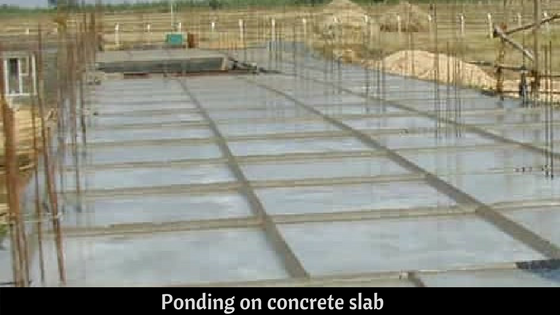
2. Wet coverings:
This type of method performed for columns, footings, and the bottom surface of slabs, where ponding is not possible. Impermeable coverings like gunny bags or hessian are required to cover the concrete; these membranes sprayed with water to keep the concrete moist.
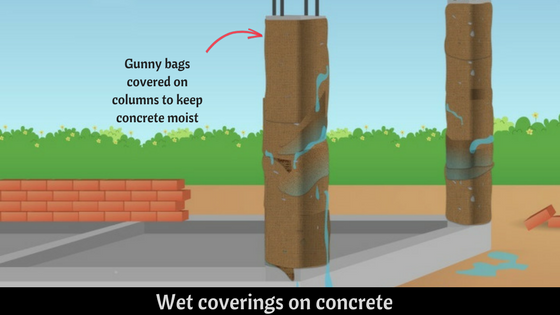
3. Membrane Curing of Concrete:
Ponding is not suitable at the places where the atmospheric temperatures are high. Water gets evaporated due to the excessive heat. Membrane curing is adopted to prevent the loss of water content due to atmospheric temperature from concrete.
Membrane curing helps seal off by forming an impermeable layer on the concrete surface, which eventually resists evaporation. This procedure is generally performed by brushing or spraying the curing compound on the concrete surface.
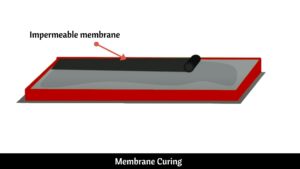
Different curing compounds are available to achieve the Membrane curing out of them, below four methods are essential and widely used.
Synthetic resin curing compound
Synthetic resin is a compound that forms as an impermeable membrane on a concrete surface to resist the water evaporation from concrete.
To proceed with further plastering, the synthetic resin membrane can be easily removed by spraying the hot water on the concrete surface. Hence it is suitable at areas where subsequent treatment applied to the concrete.
Acrylic curing compound:
Acrylic Curing compound is a polymer-based curing compound obtained from the polymers of Acrylic acid.
The best part of Acrylic based curing compound is there is no need to remove this compound for plastering. Acrylic helps to achieve excellent adhesion to plastering.
Wax Curing compound:
Wax curing has similar properties of synthetic resin. The usage of wax on the surfaces to be painted or tiled is not recommended because wax hampers the adhesion between surface and plastering or tiling.
Chlorinated rubber curing compound:
Chlorinated rubber forms a thick membrane on the concrete surface when laid. Using of chlorinated rubber-based curing compound seals the concrete effectively with no minute pores left. But the age of chlorinated rubber is very less, and it cannot stay for longer times.
4. Steam curing of concrete:
This procedure is adopted at a Precast concrete plant where the concrete members are mass-produced. Steam has heat moisture in it, and it is sprayed on the concrete surface to keep concrete moisture and also increases the concrete temperature, which eventually quickens the pace of hardening concrete.
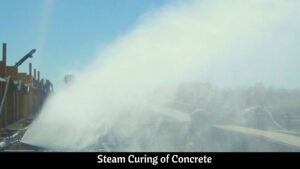
5. Curing of Concrete by infrared radiation:
This method is adopted in cold climatic regions. In this procedure, the infrared radiation is applied to the concrete, increasing the initial temperature, which increases the strength of concrete. This is the most effective method than steam curing, as raising the initial temperature in concrete does not decrease the ultimate strength of concrete. This technique is adopted for the hollow concrete members where the heaters are placed in concrete members which emit the temperature of 900
6. Curing of concrete by an Electric Current:
In this method, the concrete is cured by passing an alternating current to it. Two plates, one at top and another at the bottom of the concrete surface, acts as an electrode, and then the alternating current is passed to them. 30V or 60V of potential difference maintained among these electrodes. The curing attained by concrete at 28 days can be achieved within three days by performing this method.

FAQs on Curing of Concrete:
Also Read:
Concrete grades and mix ratio of concrete
14 Different types of cement
Important properties of Concrete
For Instant updates, Join our Whatsapp Broadcast. Save our Whatsapp contact +919700078271 as Civilread and Send us a message “JOIN.”

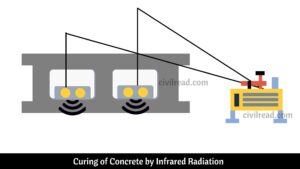
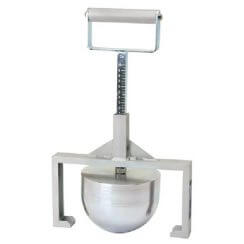
thanks for such a nice article
Good 👍information
Thks for sharing such a useful article
you make it easy for non-civil engineering to understand.
thanks
Good informative article , best for engineering students
Thank you sir. Information is very easy to understand.
Thanx sir this information is very easy.
Please also elaborate Use of Curing compound
Soon u can see this
Much Obliged Sir.
Basic things you should know about Bill Of Quantity (B.O.Q) CSI
Quantity Survey. Syllabus. How I know……
1) BILLS OF QUANTITIES (B.O.Q).
2) BILL OF QUANTITIES AS PER CSI DIVISION.
3)The Importance Of B.O.Q
4) The Major Parts Of B.O.Q
5) Preliminaries
6) Measured works
7) Provisional sums.
99% of the students don’t know that what actually the syllabus is for Gulf job Oriented.